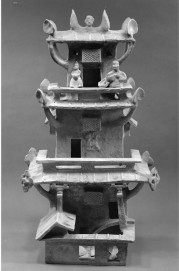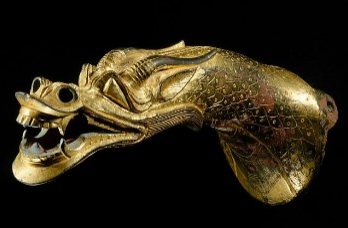4.7: The Silk Roads and the Xiongnu War
- Page ID
- 135172
To understand the origins of the immensely expensive Han-Xiongnu war, we have to go back a bit. Travel and trade across the steppe highway of Central Asia had intensified from about the middle of the fourth century BC when Alexander the Great (356 – 323), of Macedonia in Northern Greece, conquered Central Asia and northern India. Connections stretched across Eurasia. Once the Han had established peace in the former Qin territory, millions of workers, mainly women, settled down to weaving the lush, patterned silks the rest of Eurasia desired.

It was not an irreconcilable culture clash between steppe and sown that led to the Han conflict with the Xiongnu. Rather, as with the Rong, the Di, and the Hu in the Zhou period, the two sides were very much operating in the same political world. Although nomads moved around more than farmers, taking herds to new pastures every year or season, in other ways their productive lives were similar to the Shang and early Zhou, and to much of Han territory before central government really took hold. Life centered on kinfolk and clans or tribes for production, migration, and war. A stratified aristocracy dominated farming and herding commoners. Mounted aristocrats led war and large hunts; others might fight just to raid a neighboring tribe. Succession to tribal leadership was hereditary, but rather than the first son, the heir was the son with the widest popular and aristocratic support, based on proven success in leadership. The balance of production and consumption on the steppe was so delicate that even high-ranking people had to work, like the elite in Shang times.
Steppe people did rely more on animals for food than their southerner neighbors, but the steppe economy also included grain, crafts, and trade. Meanwhile, Han subjects did consume dairy products, and Han doctors considered milk a medicine, good for digestion, and urged patients to consume dairy foods every day. One early Han manuscript says that fermented mare’s milk lengthened life.10
The key difference between the Xiongnu and Han regimes lay in their political structure: confederation of tribes versus centralized empire. The first record of the nomadic Xiongnu (we do not know what language they spoke, by the way) comes when they joined a horizontal alliance of the five eastern Zhou states against Qin in 318 BC. In 214 BC, Qin General Meng Tian led an enormous army to capture the Ordos region, a flourishing Xiongnu center of trade and pastureland they needed for production. To consolidate the territory he captured, he built a Great Wall (not the one we know today). At the same time, nomads from the east were also attacking the Xiongnu. In defense against this twin threat, the tribes formed a confederation.

There was a standard way to do this in nomadic society: one man, accepted as khan, creates an honor guard of top warriors (kesig) that support him; a council of aristocrats called “kings,” with their own fiefs and troops; and an army under his control to stop internal fighting, subordinate surrounding peoples, and collect tribute in both prestige luxury goods and staples like grain. The khan distributes that tribute to his royal clan and close supporters, who pass some on to their dependents. In this case, to coordinate defense against Qin and the eastern Yuezhi, the chiefs ceded some authority to a khan named Modun (r. 209-174), who claimed a divine mandate. With an existential threat behind them and the promise of loot before them, the Xiongnu troops, under this centralized command, retook the territory Qin had taken. Aided by the fall of Qin, they kept going until they had conquered as far east as the Liaodong Peninsula, and as far west as today’s Shaanxi.
Recall that that Liu Bang, the Han founder, had initially set up some independent “kingdoms” or fiefs to settle kin and allies. In 198 BC, one of those kingdoms (confusing called Hann), under attack by the Xiongnu confederation, decided to ally with the confederation. Liu Bang personally led 320,000 infantrymen to suppress the rebellious kingdom and attack Xiongnu, but they trounced him. The Hann kingdom joined in raiding imperial Han territory. To try to keep peace along the border, Liu Bang and his successors recognized the Xiongnu as a military superior and political equal. One ruled the settled people who wore hats and sashes; the other ruled “the people who draw the bow.” Since plenty of Han people also drew bows, and anyone can put on a hat and a sash, you can see that this was not a deep-seated ethnic distinction. The two sides created a marriage alliance, meaning that children were descended from both. Han presented tribute annually of silk and other cloth, millet, gold, and other goods. The two sides recognized the Qin Long Wall as the border between their territories, and respected one another’s larger spheres of influence over smaller states and tribes.
What Modun and his successor khans needed to hold authority and keep the confederacy together was a steady flow of goods to pass down to their followers. The khan’s authority over the chiefs extended only to coordinating warfare; he could not stop Han defectors and lesser nomad chiefs from raiding. The Han side understood that quite clearly. They opened more markets along the border, ignored smuggling, and kept the tribute flowing no matter what, along with other signs of authority. They hoped to strengthen the khan enough that he could maintain the bipolar world with its clear line of division. Yet, as historian Nicola di Cosmo puts it, “no amount of Chinese support could change the core structure of nomadic society.”
The Xiongnu, on the other hand, did force change on Han government structure. Since defense in the north required skilled cavalry, the Han ended a keystone policy of legalist government, the universal male draft, and hired professional soldiers from the border areas.

The mutual recognition agreement between Han and the Xiongnu confederation lasted from 198-133 BC. Han emperor Wu (Wudi) violated the treaty by sending an official, Zhang Qian, to make an alliance with another nomadic group in 139 BC; the understanding that this was his sphere of influence accounts for the Xiongnu khan’s great rage when Zhang was intercepted. The khan wrote to the Han court in outrage: “The Yuezhi lie to the north of us – how can the Han send their envoys there? If I wished to send envoys to Viet [in the far south], would the Han allow me to do so?” The Xiongnu held Zhang Qian for 10 years. He spent the decade learning all he could about Central Asia, so that when he finally escaped he was able to travel to present-day Kyrgyzstan, Uzbekistan, and Afghanistan, bringing back to the Han court in 126 BC word of the outside world as far as Rome – and in particular of the vast potential market for Chinese silks. Meanwhile, frustrated with the constant raids coming on top of tribute payments, Wudi launched a series of attacks on the Xiongnu, initially presented as defensive.
As the war continued, Wudi sent soldiers ever further west. He saw that until he controlled the trade routes across Central Asia, the Xiongnu could always be resupplied and keep fighting. So, over the objections of courtiers, Wudi sent troops right through the Gobi Desert up to Ulan Bator in Mongolia, and eventually set up military commanderies and civil counties in the oases that had supplied the Xiongnu. Supplying the troops was difficult and stupid leaders did not help: one commander insisted on setting up a kickball field (the game was used for training), even though his troops were hungry.12 Settlers from inside Han were sent out West from about 60 BC onwards.13 The war cost hundreds of thousands of lives and horses, and about 189 trillion copper cash. Wudi raised it through new taxes on merchant inventories, and government monopolies on mining, on minting cash, and on making and selling iron, salt, and alcohol.

Confucian officials like Jia Yi and Sima Qian opposed not only the spending of that cash on war but also the way monopolies undermined free trade and hurt ordinary families. Envisioning a society built on strong married couples, they opposed both the hiring of young women to work in government silk factories and the expenditure of manpower on the Wudi’s never-ending military campaigns. The first pulled young women away from the family by allowing them to delay marriage, living on their wages; and the second pulled young men away from the family by sending them out into the deserts to fight.14 Wudi paid no attention.


